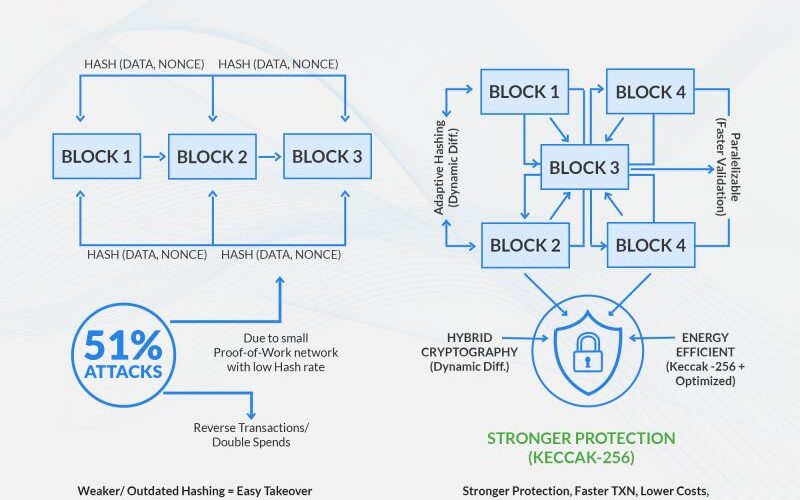Why 51% Attacks Happen
51% attacks on smaller blockchains usually happen because their hash functions are not keeping up. Weak or outdated hashing makes it easy for a single actor to take over and rewrite history.
Most blockchain developers know how hash functions like SHA-256 or Keccak-256 connect blocks. They secure large networks well, but smaller chains with limited hashing power can become easy targets.
Once one actor controls the majority of hashing power, they can:
-
Reverse transactions
-
Double-spend coins
This has already caused multi-million dollar losses in smaller networks.
Strengthening Blockchains Against 51% Attacks
The good news: there are ways to make blockchains more resilient.
Adaptive Hash Functions
Adjust difficulty based on network activity, making it much harder for a single participant to dominate.
Parallelizable Hashing
Allows blocks to be validated faster without compromising security — essential for high-throughput chains.
Hybrid Cryptography
Mixing multiple hash algorithms removes single points of failure and strengthens the chain.
Energy-Efficient Hashing
Optimized algorithms reduce computational load, allowing smaller miners to participate and improving decentralization.
Tangible Benefits of Stronger Hashing
These improvements translate into direct gains:
-
Stronger protection for smaller chains against 51% attacks
-
Higher throughput for DeFi apps and blockchain games
-
Lower costs + improved network integrity, making projects more attractive to users and contributors
The Bigger Picture: Hashing as Strategy
Hashing strategy is no longer just a technical detail. It shapes how:
-
Secure a blockchain is
-
Decentralized the network remains
-
Resilient the system can be against attacks
For emerging chains, every decision around hashing determines whether the network can withstand concentrated attacks or scale safely.
Outdated or weak hash functions create vulnerabilities that:
-
Erode trust
-
Drive away users
-
Limit growth
Future-proofing your blockchain means adopting adaptive, hybrid, or energy-efficient hashing — not just patching problems.







